Abstract
Skeletal muscle bioenergetics and control of intracellular pH have been investigated in 46 patients with chronic fatigue syndrome by phosphorus magnetic resonance spectroscopy. The results have been compared with those from healthy controls and from a group of patients with mitochondrial cytopathies affecting skeletal muscle. No consistent abnormalities of glycolysis, mitochondrial metabolism or pH regulation were identified in the group when taken as a whole, although in 12 of the 46 patients the relationship between pH and phosphocreatine utilisation during exercise fell outside the normal range. Of these, 6 patients showed increased acidification relative to phosphocreatine depletion while 6 showed reduced acidification. These findings do not support the hypothesis that any specific metabolic abnormality underlies fatigue in this syndrome although abnormalities may be present in a minority of patients.
Full text
PDF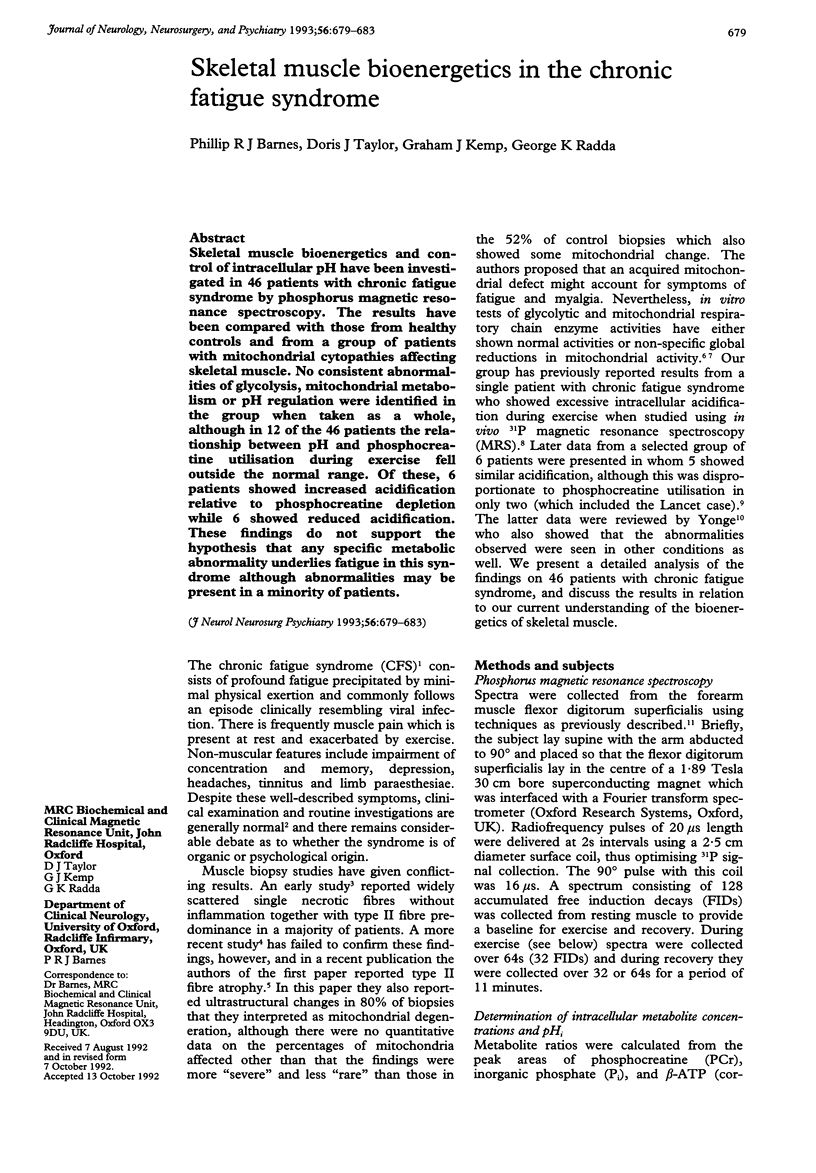
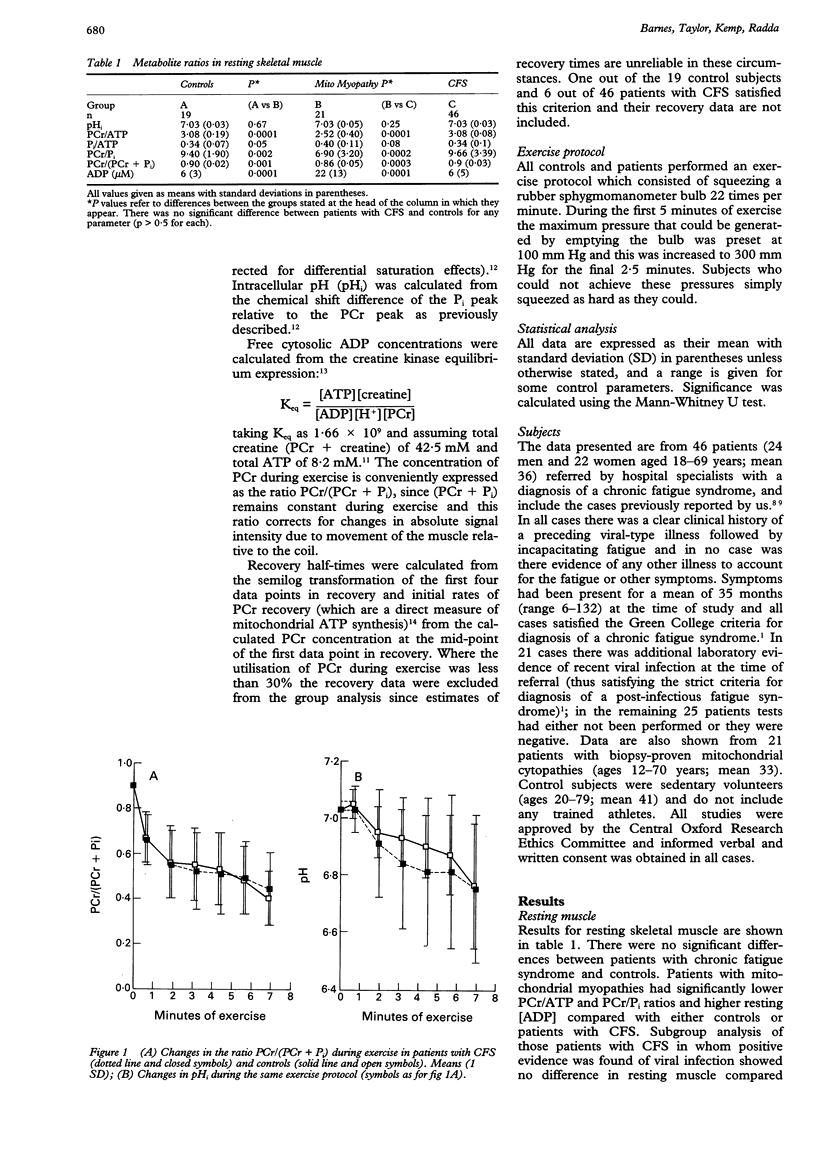
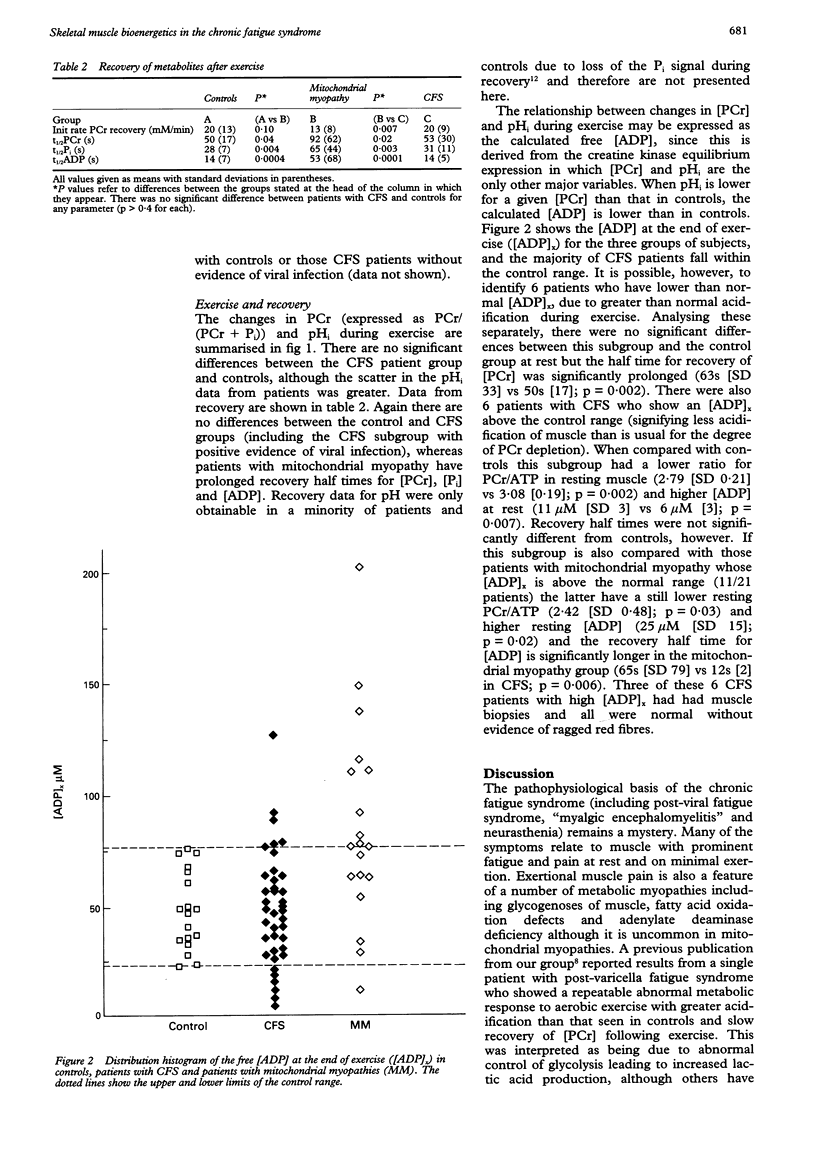
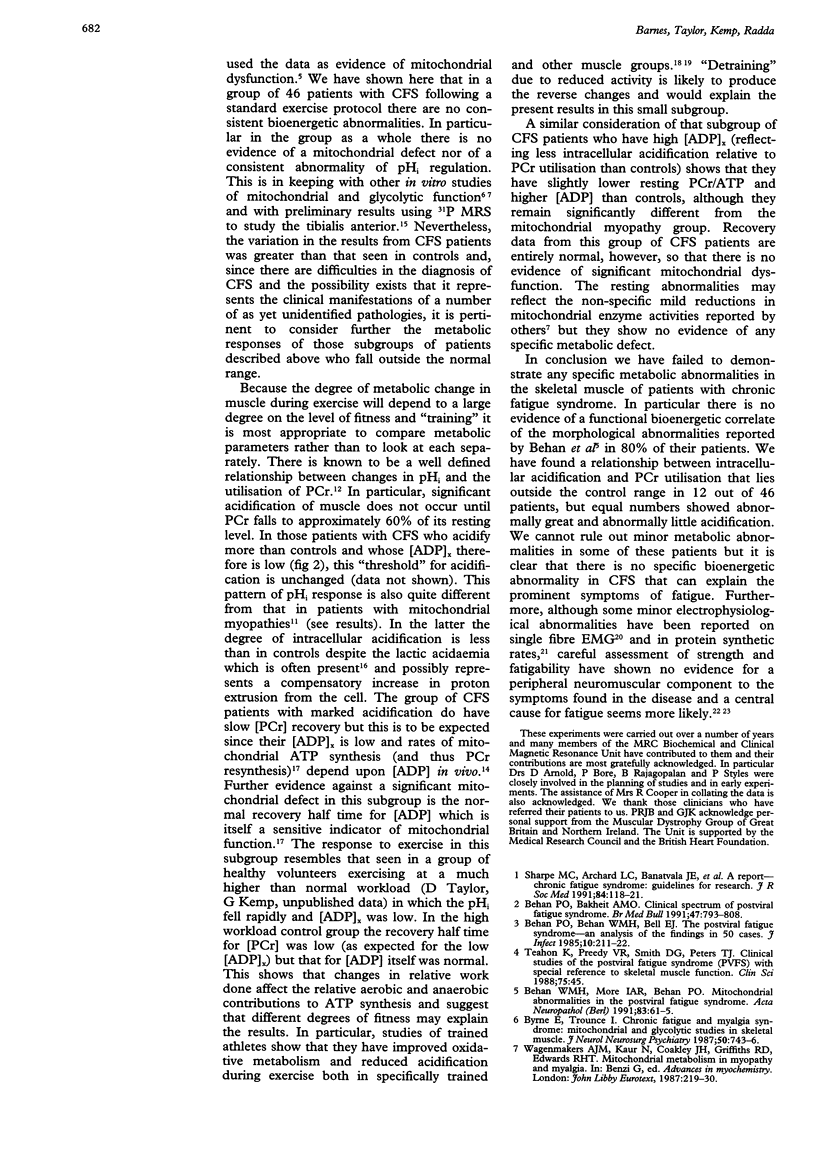
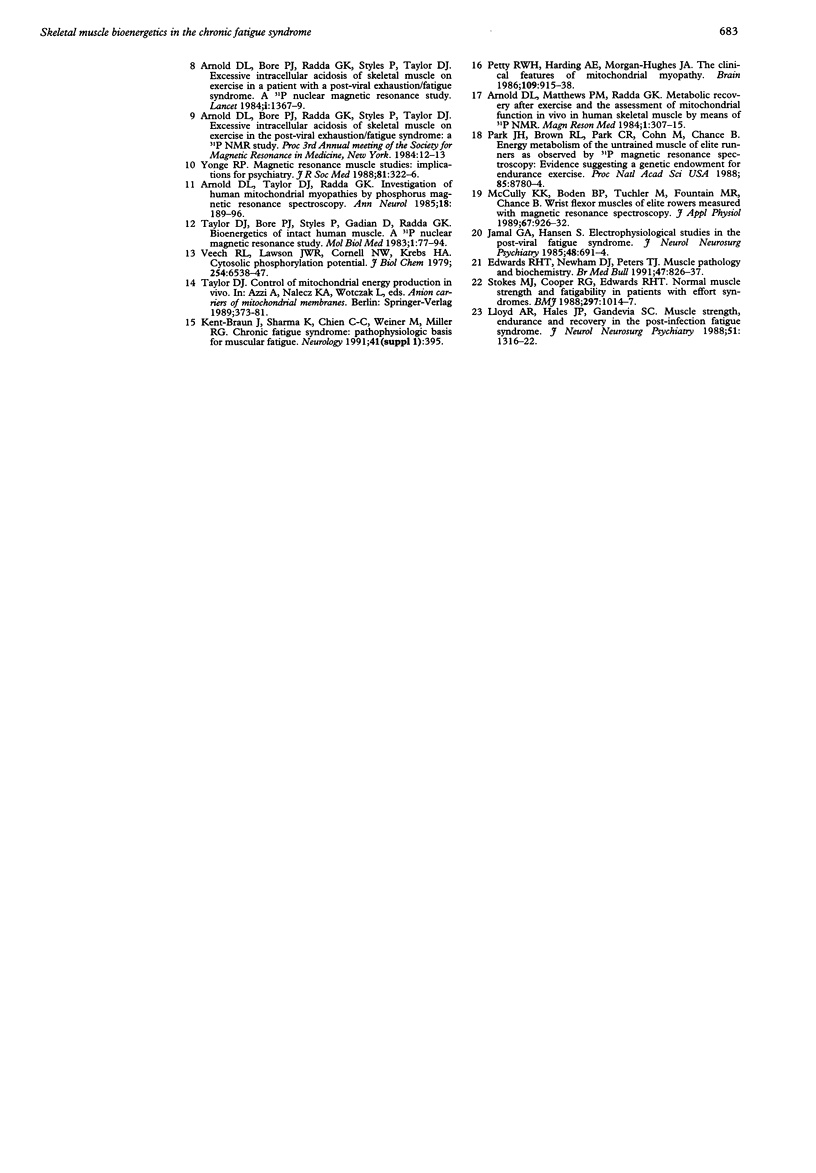
Selected References
These references are in PubMed. This may not be the complete list of references from this article.
- Arnold D. L., Bore P. J., Radda G. K., Styles P., Taylor D. J. Excessive intracellular acidosis of skeletal muscle on exercise in a patient with a post-viral exhaustion/fatigue syndrome. A 31P nuclear magnetic resonance study. Lancet. 1984 Jun 23;1(8391):1367–1369. doi: 10.1016/s0140-6736(84)91871-3. [DOI] [PubMed] [Google Scholar]
- Arnold D. L., Matthews P. M., Radda G. K. Metabolic recovery after exercise and the assessment of mitochondrial function in vivo in human skeletal muscle by means of 31P NMR. Magn Reson Med. 1984 Sep;1(3):307–315. doi: 10.1002/mrm.1910010303. [DOI] [PubMed] [Google Scholar]
- Arnold D. L., Taylor D. J., Radda G. K. Investigation of human mitochondrial myopathies by phosphorus magnetic resonance spectroscopy. Ann Neurol. 1985 Aug;18(2):189–196. doi: 10.1002/ana.410180205. [DOI] [PubMed] [Google Scholar]
- Behan P. O., Bakheit A. M. Clinical spectrum of postviral fatigue syndrome. Br Med Bull. 1991 Oct;47(4):793–808. doi: 10.1093/oxfordjournals.bmb.a072511. [DOI] [PubMed] [Google Scholar]
- Behan P. O., Behan W. M., Bell E. J. The postviral fatigue syndrome--an analysis of the findings in 50 cases. J Infect. 1985 May;10(3):211–222. doi: 10.1016/s0163-4453(85)92488-0. [DOI] [PubMed] [Google Scholar]
- Behan W. M., More I. A., Behan P. O. Mitochondrial abnormalities in the postviral fatigue syndrome. Acta Neuropathol. 1991;83(1):61–65. doi: 10.1007/BF00294431. [DOI] [PubMed] [Google Scholar]
- Byrne E., Trounce I. Chronic fatigue and myalgia syndrome: mitochondrial and glycolytic studies in skeletal muscle. J Neurol Neurosurg Psychiatry. 1987 Jun;50(6):743–746. doi: 10.1136/jnnp.50.6.743. [DOI] [PMC free article] [PubMed] [Google Scholar]
- Edwards R. H., Newham D. J., Peters T. J. Muscle biochemistry and pathophysiology in postviral fatigue syndrome. Br Med Bull. 1991 Oct;47(4):826–837. doi: 10.1093/oxfordjournals.bmb.a072514. [DOI] [PubMed] [Google Scholar]
- Jamal G. A., Hansen S. Electrophysiological studies in the post-viral fatigue syndrome. J Neurol Neurosurg Psychiatry. 1985 Jul;48(7):691–694. doi: 10.1136/jnnp.48.7.691. [DOI] [PMC free article] [PubMed] [Google Scholar]
- Lloyd A. R., Hales J. P., Gandevia S. C. Muscle strength, endurance and recovery in the post-infection fatigue syndrome. J Neurol Neurosurg Psychiatry. 1988 Oct;51(10):1316–1322. doi: 10.1136/jnnp.51.10.1316. [DOI] [PMC free article] [PubMed] [Google Scholar]
- McCully K. K., Boden B. P., Tuchler M., Fountain M. R., Chance B. Wrist flexor muscles of elite rowers measured with magnetic resonance spectroscopy. J Appl Physiol (1985) 1989 Sep;67(3):926–932. doi: 10.1152/jappl.1989.67.3.926. [DOI] [PubMed] [Google Scholar]
- Newton H. B., Fleisher M., Schwartz M. K., Malkin M. G. Glucosephosphate isomerase as a CSF marker for leptomeningeal metastasis. Neurology. 1991 Mar;41(3):395–398. doi: 10.1212/wnl.41.3.395. [DOI] [PubMed] [Google Scholar]
- Park J. H., Brown R. L., Park C. R., Cohn M., Chance B. Energy metabolism of the untrained muscle of elite runners as observed by 31P magnetic resonance spectroscopy: evidence suggesting a genetic endowment for endurance exercise. Proc Natl Acad Sci U S A. 1988 Dec;85(23):8780–8784. doi: 10.1073/pnas.85.23.8780. [DOI] [PMC free article] [PubMed] [Google Scholar]
- Petty R. K., Harding A. E., Morgan-Hughes J. A. The clinical features of mitochondrial myopathy. Brain. 1986 Oct;109(Pt 5):915–938. doi: 10.1093/brain/109.5.915. [DOI] [PubMed] [Google Scholar]
- Sharpe M. C., Archard L. C., Banatvala J. E., Borysiewicz L. K., Clare A. W., David A., Edwards R. H., Hawton K. E., Lambert H. P., Lane R. J. A report--chronic fatigue syndrome: guidelines for research. J R Soc Med. 1991 Feb;84(2):118–121. doi: 10.1177/014107689108400224. [DOI] [PMC free article] [PubMed] [Google Scholar]
- Stokes M. J., Cooper R. G., Edwards R. H. Normal muscle strength and fatigability in patients with effort syndromes. BMJ. 1988 Oct 22;297(6655):1014–1017. doi: 10.1136/bmj.297.6655.1014. [DOI] [PMC free article] [PubMed] [Google Scholar]
- Taylor D. J., Bore P. J., Styles P., Gadian D. G., Radda G. K. Bioenergetics of intact human muscle. A 31P nuclear magnetic resonance study. Mol Biol Med. 1983 Jul;1(1):77–94. [PubMed] [Google Scholar]
- Veech R. L., Lawson J. W., Cornell N. W., Krebs H. A. Cytosolic phosphorylation potential. J Biol Chem. 1979 Jul 25;254(14):6538–6547. [PubMed] [Google Scholar]
- Yonge R. P. Magnetic resonance muscle studies: implications for psychiatry. J R Soc Med. 1988 Jun;81(6):322–326. doi: 10.1177/014107688808100607. [DOI] [PMC free article] [PubMed] [Google Scholar]


